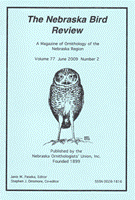Nebraska Ornithologists' Union

Nebraska Bird Review
Date of this Version
12-2017
Document Type
Article
Citation
The Nebraska Bird Review Vol. 85 No. 4 (2017), pp 146-178
Abstract
This fall season will be remembered as the fall with the mega-rarities. There were five, one of which, Pacific Wren, is a first Nebraska record. Based on occurrence dates, Hurricane Irma appears to have influenced the appearance of two of the megas, Black Vulture and Magnificent Frigatebird, neither of which provided opportunities for observers to view them, but both well-documented with photographs. There were an extraordinary TWO sightings of Harris’s Hawk, which together with the presence as of this writing (December 19) of one in northeast Kansas and a view of the species map in eBird strongly suggest a single bird was involved in all three occurrences. Finally, and by no means least, a Williamson’s Sapsucker was photographed by Boni Edwards while she was looking for a Yellow-bellied Sapsucker! Cameras rock. Another mega event was a rather short-lived but intense invasion by Red Crossbills. They arrived in a bunch, peaked in numbers in late October, and gradually faded away. There were around 170 reports through the period, with an estimated total of around 1360 individual birds. Significant among the multitudes of expected Type 2 birds were the first Nebraska recordings of Type 4, “Douglas Fir Crossbill”. Much of the rest of the Fall Seasonal Report deals with mundane-bycomparison trends. There were summer records of ducks that don’t breed in Nebraska, like Ring-necked Duck and Lesser Scaup. There were several shorebird species that lingered late into November, including a Wilson’s Phalarope photographed in late November, record late by a month. Similarly, several sparrow species lingered rather late as well.
Included in
Ornithology Commons, Population Biology Commons, Poultry or Avian Science Commons, Zoology Commons


Comments
Published by the Nebraska Ornithologists’ Union, Inc.